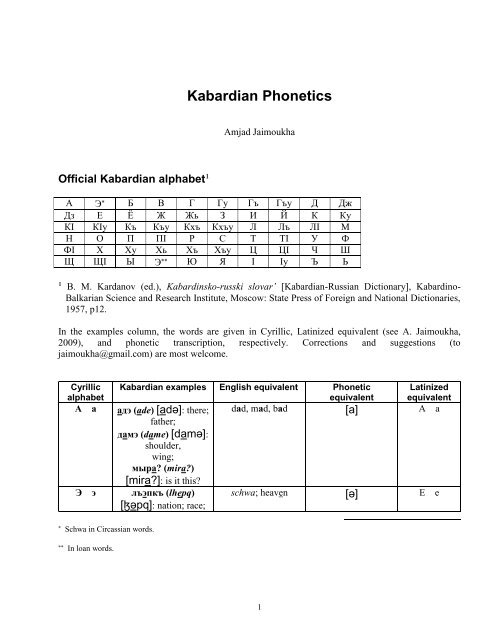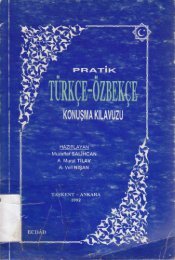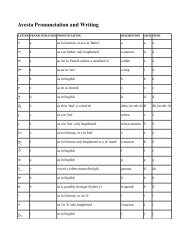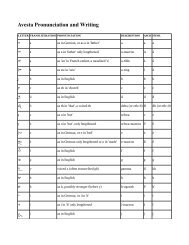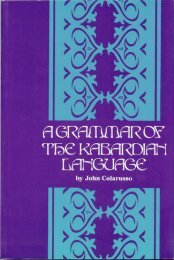Kabardian-Phonetics
You also want an ePaper? Increase the reach of your titles
YUMPU automatically turns print PDFs into web optimized ePapers that Google loves.
<strong>Kabardian</strong> <strong>Phonetics</strong><br />
Amjad Jaimoukha<br />
Official <strong>Kabardian</strong> alphabet¹<br />
А Э Б В Г Гу Гъ Гъу Д Дж<br />
Дз Е Ё Ж Жь З И Й К Ку<br />
КI КIу Къ Къу Кхъ Кхъу Л Лъ ЛI М<br />
Н О П ПI Р С Т ТI У Ф<br />
ФI Х Ху Хь Хъ Хъу Ц ЦI Ч Ш<br />
Щ ЩI Ы Э Ю Я I Iу Ъ Ь<br />
¹ B. M. Kardanov (ed.), Kabardinsko-russki slovar’ [<strong>Kabardian</strong>-Russian Dictionary], Kabardino-<br />
Balkarian Science and Research Institute, Moscow: State Press of Foreign and National Dictionaries,<br />
1957, p12.<br />
In the examples column, the words are given in Cyrillic, Latinized equivalent (see A. Jaimoukha,<br />
2009), and phonetic transcription, respectively. Corrections and suggestions (to<br />
jaimoukha@gmail.com) are most welcome.<br />
Cyrillic<br />
alphabet<br />
А а<br />
Э э<br />
<strong>Kabardian</strong> examples<br />
адэ (ade) [adə]: there;<br />
father;<br />
дамэ (dame) [damə]:<br />
shoulder,<br />
wing;<br />
мыра? (mira?)<br />
[mira?]: is it this?<br />
лъэпкъ (lhepq)<br />
[ɮəpq]: nation; race;<br />
English equivalent<br />
dad, mad, bad<br />
schwa; heaven<br />
Phonetic<br />
equivalent<br />
[a]<br />
[ə]<br />
Latinized<br />
equivalent<br />
A a<br />
E e<br />
<br />
Schwa in Circassian words.<br />
<br />
In loan words.<br />
1
(initial<br />
only in<br />
loan<br />
words; see<br />
the other<br />
entry ‘э’<br />
below)<br />
Б б<br />
В в<br />
Г г<br />
Гу гу<br />
Гъ гъ<br />
Гъу гъу<br />
breed;<br />
напэ (nape) [napə]:<br />
face<br />
балыджэ (balije)<br />
[baliʤə]: radish;<br />
нобэ (nobe) [nobə]:<br />
today;<br />
къэб (qeb) [qəb]:<br />
pumpkin<br />
вы (vi) [vi]: bull;<br />
гъэвэн (gheven)<br />
[ʁəvən]: to boil;<br />
бэв (bev) [bəv]:<br />
abundant (of crops)<br />
гын (gin) [ɣin]:<br />
gunpowder;<br />
гъуэгын (ghwegin)<br />
[ʁʷəɣin]: to weep;<br />
жыг (zhig) [ʒiɣ]: tree<br />
гу (gw) [gʷ]: heart;<br />
гуэгуэн (gwegwen)<br />
[gʷəgʷən]: large<br />
metal pitcher;<br />
дэгу (degw) [dəgʷ]:<br />
deaf<br />
гъащIэ (ghasch’e)<br />
[ʁaʆˀə]: life;<br />
гъэгъа (ghegha)<br />
[ʁəʁa]: flower;<br />
гъэдыргъ (ghedirgh)<br />
[ʁədirʁ]: clang<br />
гъуэгу (ghwegw)<br />
[ʁʷəgʷ]: way, road;<br />
мыгъуэ (mighwe)<br />
B b<br />
V v<br />
Spanish/Dutch g,<br />
e.g. lago<br />
[In some <strong>Kabardian</strong><br />
dialects, ‘г’ in noninitial<br />
positions is<br />
pronounced as ‘й’]<br />
Gwent,<br />
hard ‘g’ followed by<br />
very short ‘u’ (as<br />
first sound of the<br />
English word<br />
‘wood’)<br />
Parisian r<br />
гъ + w<br />
Parisian r followed<br />
by very short ‘u’ (as<br />
[b]<br />
[v]<br />
[ɣ]<br />
[gʷ]<br />
[ʁ]<br />
[ʁʷ]<br />
B b<br />
V v<br />
G g<br />
Gw gw<br />
Gh gh<br />
Ghw ghw<br />
2
Д д<br />
Дж дж<br />
Дз дз<br />
Е е<br />
(never in<br />
final<br />
position)<br />
Ё ё<br />
[miʁʷə]: misfortune;<br />
гъунэгъу (ghwneghw)<br />
[ʁʷnəʁʷ]: neighbour<br />
дэнэ (dene) [dənə]:<br />
where;<br />
дадэ (dade) [dadə]:<br />
grandpa;<br />
джэд (jed) [ʤəd]:<br />
hen<br />
джэгун (jegwn)<br />
[ʤəgʷn]: to play;<br />
еджапIэ (yejap’e)<br />
[jəʤapˀə]: school;<br />
дыдж (dij) [diʤ] :<br />
bitter<br />
дзэ (dze) [ʣə]: tooth;<br />
army; едзын (yedzin)<br />
[jəʤin]: to hurl;<br />
гуэдз (gwedz)<br />
[gʷəʣ]: wheat<br />
ен (yen) [jən]: whole,<br />
entire; зекIуэ (zeik'we)<br />
[zekˀʷə]: campaign,<br />
outing<br />
only in Russian<br />
adoptions:<br />
ёлкэ (yolke) [jolkə]:<br />
fir(-tree);<br />
ёрш (yorsh) [jorʃ]:<br />
ruff (small freshwater<br />
fish)<br />
first sound of the<br />
English word<br />
‘wood’)<br />
D d<br />
J j<br />
adze<br />
when initial: y +<br />
schwa (as in ‘yep’);<br />
when in middle of<br />
word: day (short and<br />
undiphthongized)<br />
York<br />
[d]<br />
[ʤ]<br />
[ʣ]<br />
initial:<br />
[jə]<br />
middle:<br />
[e]<br />
[jo]<br />
D d<br />
J j<br />
Dz dz<br />
initial:<br />
Ye ye<br />
middle:<br />
ei<br />
Yo<br />
yo<br />
3
Ж ж<br />
Жь жь<br />
З з<br />
И и<br />
Й й<br />
жэм (zhem) [ʒəm]:<br />
cow;<br />
къуажэ (qwazhe)<br />
[qʷaʒə]: village;<br />
лъэмыж (lhemizh)<br />
[ɮəmiʒ]: bridge<br />
жьэ (zche) [ʑə]:<br />
mouth;<br />
мажьэ (mazche)<br />
[maʑə]: comb;<br />
лэгъупэжь<br />
(leghwpezch)<br />
[ləʁʷpəʑ]: leader of<br />
herdsmen<br />
зы (zi) [zi]: one;<br />
Iэзэ (’eze) [ʔəzə]:<br />
skilful;<br />
мэз (mez) [məz]:<br />
forest<br />
ибэ (yibe) [jibə]:<br />
orphan;<br />
тхылъибл (txilhiybl)<br />
[txiɮijbl]: seven<br />
books;<br />
си (siy) [sij]: my<br />
йоплъэ (yoplhe)<br />
[jopɮə]: ([he/she] is<br />
looking/looks into<br />
smth.);<br />
фIейуэ (f’eiywe)<br />
[fˀejwə]: in a dirty<br />
manner;<br />
фIей (f’eiy) [fˀej]:<br />
dirty<br />
genre, erasure<br />
alveolo-palatal zh<br />
Z z<br />
when initial it is<br />
pronounced as ‘Yi’<br />
in Yiddish; when<br />
within word or final,<br />
it is pronounced as<br />
‘ee’ in<br />
see<br />
hay, day<br />
[ʒ]<br />
[ʑ]<br />
[z]<br />
initial:<br />
[ji]<br />
middle or final:<br />
[ij]<br />
[j]<br />
Zh zh<br />
Zch zch<br />
Z z<br />
initial:<br />
Yi yi<br />
middle or<br />
final:<br />
iy<br />
Y<br />
y<br />
К к<br />
there are no native<br />
words in literary<br />
<strong>Kabardian</strong> that have<br />
K k<br />
[k]<br />
K k<br />
4
Ку ку<br />
КI кI<br />
КIу кIу<br />
Къ къ<br />
Къу къу<br />
this sound; the<br />
equivalent is ch; used<br />
only in dialects and<br />
loan<br />
words, e.g.<br />
кассэ (kasse)<br />
[kassə]: cash-desk;<br />
стэкан (stekan)<br />
[stəkan]: cup, glass;<br />
рак (rak) [rak]:<br />
cancer<br />
ку (kw) [kʷ]: middle,<br />
centre;<br />
дэкун (dekwn)<br />
[dəkʷn]: to cram,<br />
stuff;<br />
хэку (xekw) [xəkʷ]:<br />
country<br />
кIэ (ch’e) [ʧˀə]: tail,<br />
end; хэкIын (xech’in)<br />
[xəʧˀin]: to emerge<br />
(from some mass);<br />
фIэкI (f’ech’) [fˀəʧˀ]:<br />
except<br />
кIуэн (k’wen)<br />
[kˀʷən]: to go;<br />
къэкIуэн (qek’wen)<br />
[qəkˀʷən]: to come;<br />
емыкIу (yemik’w)<br />
[jəmikˀʷ]: improper<br />
къакIуэ (qak’we)<br />
[qakˀʷə]: come here;<br />
адакъэ (adaqe)<br />
[adaqə]: cock;<br />
къыкъ (qiq) [qiq]:<br />
stammerer<br />
къуэлэн (qwelen)<br />
[qʷələn]: speckled,<br />
could<br />
ч followed<br />
by glottal stop<br />
ку with glottal stop<br />
after к<br />
Arabic<br />
ق къ + w<br />
w = very short ‘u’<br />
[kʷ]<br />
[ʧˀ]<br />
[kˀʷ]<br />
[q]<br />
[qʷ]<br />
Kw kw<br />
Ch’ ch’<br />
K’w k’w<br />
Q q<br />
Qw qw<br />
5
Кхъ кхъ<br />
Кхъу<br />
кхъу<br />
Л л<br />
Лъ лъ<br />
ЛI лI<br />
М м<br />
spotted;<br />
дыкъуакъуэ<br />
(diqwaqwe)<br />
[diqʷaqʷə]: fork,<br />
bifurcation;<br />
мэкъу (meqw)<br />
[məqʷ]: hay<br />
кхъаблэ (q’able)<br />
[qχablə]: grave;<br />
фIэкхъыу (f’eq’iu)<br />
[fˀəqχiu]: absolutely;<br />
бэкхъ (beq’) [bəqχ]:<br />
cow-shed<br />
кхъуэ (q’we) [qχʷə]:<br />
pig, swine;<br />
хыкхъуэ (xiq’we)<br />
[xiqχʷə]: porpoise<br />
(sea creature);<br />
кIакхъу (ch’aq’w)<br />
[ʧˀaqχʷ]: gun cocking<br />
piece<br />
лы (li) [li]: meat;<br />
дэлэн (delen)<br />
[dələn]: pie;<br />
мыл (mil) [mil]: ice<br />
лъапIэ (lhap’e)<br />
[ɮapˀə]: expensive;<br />
дэлъэн (delhen)<br />
[dəɮən]: to stroke;<br />
гулъ (gwlh) [gʷɮ]:<br />
bud<br />
лIы (l’i) [ɮˀi]: man;<br />
мылIэн (mil’en)<br />
[miɮˀən]: not to die;<br />
пщылI (pschil’)<br />
[pʆiɮˀ]: slave<br />
модэ (mode) [modə]:<br />
there;<br />
(as in first sound of<br />
English ‘wood’)<br />
къ + хъ<br />
кхъ + w<br />
w = very short ‘u’<br />
(as in first sound of<br />
English ‘wood’)<br />
L l<br />
Welsh ll , e.g.<br />
Llewellyn<br />
лъ followed by<br />
glottal stop<br />
M m<br />
[qχ]<br />
[qχʷ]<br />
[l]<br />
[ɮ]<br />
[ɮˀ]<br />
[m]<br />
Q’ q’<br />
Q’w q’w<br />
L l<br />
Lh lh<br />
L’ l’<br />
M m<br />
6
Н н<br />
О о<br />
(initial<br />
only in<br />
loan<br />
words;<br />
final in<br />
very few<br />
words)<br />
П п<br />
ПI<br />
Р р<br />
пI<br />
(initial<br />
only in<br />
loan<br />
words)<br />
С с<br />
къамэ (qame)<br />
[qamə]: dagger;<br />
уэрам (weram)<br />
[wəram]: street<br />
нэ (ne) [nə]: eye;<br />
уанэ (wane) [wanə]:<br />
saddle;<br />
сын (sin) [sin]: statue,<br />
monument<br />
опыт (opit) [opit]:<br />
experiment, test;<br />
содэ (sode) [sodə]: I<br />
accept;<br />
псо (pso) [pso]:<br />
unharmed, intact;<br />
лъэпощхьэпо<br />
(lheposchhepo)<br />
[ɮəpo ʆħəpo]:<br />
barrier, hurdle<br />
пэ (pe) [pə]: nose;<br />
напэ (nape) [napə]:<br />
face;<br />
нып (nip) [nip]: flag<br />
пIэрэ? (p’ere?)<br />
[pˀərə?]: really?;<br />
пIапIу (p’ap’u) [pˀa<br />
pˀu]: milk (child’s<br />
word);<br />
IэрыпI (’erip’)<br />
[ʔəripˀ]:<br />
domesticated, tame<br />
роман (roman)<br />
[roman]: novel;<br />
мэрем (mereim)<br />
[mərem]: Friday;<br />
мыр (mir) [mir]: this<br />
сымаджэ (simaje)<br />
N n<br />
So (not<br />
diphthongized)<br />
P p<br />
p followed by<br />
glottal stop<br />
rat (‘rolled’)<br />
S s<br />
[n]<br />
[o]<br />
[p]<br />
[pˀ]<br />
[r]<br />
[s]<br />
N n<br />
O o<br />
P p<br />
P’ p’<br />
R r<br />
S s<br />
7
Т т<br />
ТI тI<br />
У у<br />
Ф ф<br />
ФI фI<br />
[simaʤə]: sick, ill;<br />
кIуэсэн (k’wesen)<br />
[kˀʷəsən]: to elope;<br />
тIыс (t’is) [tˀis]: sit<br />
down<br />
танэ (tane) [tanə]:<br />
calf;<br />
сату (satu) [satu]:<br />
trade;<br />
къат (qat) [qat]:<br />
level, layer<br />
тIы (t’i) [tˀi]: ram;<br />
ятIэ (yat’e) [yatˀə]:<br />
mud;<br />
уэтIпсытI (wet’psit’)<br />
[wətˀpsitˀ]: damp (of<br />
weather)<br />
унэ (wine) [winə]:<br />
house;<br />
уадэ (wade) [wadə]:<br />
hammer;<br />
пуд (pud) [pud]:<br />
cheap;<br />
къэуат (qewat)<br />
[qəwat]: nutritious;<br />
къару (qaru) [qaru]:<br />
strength<br />
псынщIэу<br />
(psinsch’ew)<br />
[psinʆˀəw]: quickly<br />
фэ (fe) [fə]: skin;<br />
къэфэн (qefen)<br />
[qəfən]: to dance;<br />
нэф (nef) [nəf]: blind<br />
фIы (f’i) [fˀi]: of good<br />
quality;<br />
зэфIэкI (zef’ech’)<br />
[zəfˀəʧˀ]: initiative;<br />
T t<br />
t followed by glottal<br />
stop<br />
initial and followed<br />
by consonant as in<br />
‘win’;<br />
long as in ‘moon’;<br />
short as in ‘wag’<br />
F f<br />
f followed by<br />
glottal stop<br />
[t]<br />
[tˀ]<br />
initial and followed<br />
by consonant:<br />
[wi]<br />
long:<br />
[u]<br />
short:<br />
[w]<br />
[f]<br />
[fˀ]<br />
T t<br />
T’ t’<br />
initial and<br />
followed by<br />
consonant:<br />
Wi wi<br />
long:<br />
U u<br />
short:<br />
W w<br />
F f<br />
F’ f’<br />
8
Х х<br />
Ху ху<br />
Хь хь<br />
Хъ хъ<br />
Хъу хъу<br />
Ц ц<br />
лIыфI (l’if’) [ɮˀifˀ]:<br />
good man<br />
хадэ (xade) [xadə]:<br />
garden;<br />
махэ (maxe) [maxə]:<br />
weak;<br />
зыкъизых (ziqiyzix)<br />
[ziqijzix]: welldressed<br />
ху (xw) [xʷ]: millet;<br />
къэщэхун<br />
(qeschexwn)<br />
[qəʆəxʷn]: to buy;<br />
дэлъху (delhxw)<br />
[dəɮxʷ]: brother (of a<br />
woman)<br />
хьэ (he) [ħə]: dog;<br />
barley;<br />
пыхьэн (pihen)<br />
[piħən]: to weap;<br />
кхъухь (q’wh)<br />
[qχʷħ]: ship<br />
хъарбыз (x’arbiz)<br />
[χarbiz]: water-melon;<br />
малъхъэ (malhx’e)<br />
[maɮχə]: son-in-law;<br />
цырхъ (tsirx’) [cirχ]:<br />
flimsy<br />
хъумэн (x’wmen)<br />
[χʷmən]: to guard,<br />
protect;<br />
мыхъур (mix’wr)<br />
[miχʷr]: seal;<br />
жьэхъу (zchex’w)<br />
[ʑəχʷ]: rude person<br />
цы (tsi) [ci]: hair;<br />
бацэ (batse) [bacə]:<br />
shaggy;<br />
Scottish/German ch,<br />
e.g. loch, ich<br />
x + w<br />
Scottish/German ch,<br />
e.g. loch, ich,<br />
followed by very<br />
short ‘u’ (as in first<br />
sound of English<br />
‘wood’)<br />
ح Arabic<br />
Spanish j, e.g. jarra<br />
خ Arabic<br />
x’ + w<br />
Spanish j (or Arabic<br />
followed by very (خ<br />
short ‘u’ (as in first<br />
sound of English<br />
‘wood’)<br />
cats, bits<br />
[x]<br />
[xʷ]<br />
[ħ]<br />
[χ]<br />
[χʷ]<br />
[c]<br />
X x<br />
Xw xw<br />
H h<br />
X’ x’<br />
X’w x’w<br />
Ts ts<br />
9
ЦI цI<br />
Ч ч<br />
Ш ш<br />
Щ щ<br />
ЩI щI<br />
Ы ы<br />
лыц (lits) [lic]: moss<br />
цIэ (ts’e) [cˀə]: name;<br />
мацIэ (mats’e)<br />
[macˀə]:<br />
grasshopper, locust;<br />
кIуэцI (k’wets’)<br />
[kˀʷəcˀ]: internal<br />
чын (chin) [ʧin]:<br />
whirligig;<br />
пычын (pichin)<br />
[piʧin]: to tear off;<br />
хьэлэч (helech)<br />
[ħələʧ]: bad, spoilt<br />
шатэ (shate) [ʃatə]:<br />
soured cream;<br />
къэшэн (qeshen)<br />
[qəʃən]: fiancée;<br />
емызэш (yemizesh)<br />
[jəmizəʃ]:<br />
indefatigable<br />
щэн (schen) [ʆən]: to<br />
sell; пщащэ<br />
(pschasche) [pʆaʆə]:<br />
girl;<br />
уэщ (wesch) [wəʆ]:<br />
axe<br />
щIалэ (sch’ale)<br />
[ʆˀalə]: boy, lad;<br />
хьэщIэ (hesch’e)<br />
[ħəʆˀə]: guest;<br />
пщIыпщI<br />
(psch’ipsch’)<br />
[pʆˀipʆˀ]: sparkling<br />
ыIы (i’i) [iʔi]: no;<br />
фыз (fiz) [fiz]:<br />
woman;<br />
къамышы (qamishi)<br />
[qamiʃi]: whip<br />
ц (ts) followed by<br />
glottal stop<br />
chest, chair<br />
shoot<br />
alveolo-palatal sh<br />
щ followed by<br />
glottal stop<br />
bin, din, sin<br />
[cˀ]<br />
[ʧ]<br />
[ʃ]<br />
[ʆ]<br />
[ʆˀ]<br />
[i]<br />
Ts’ ts’<br />
Ch ch<br />
Sh sh<br />
Sch sch<br />
Sch’ sch’<br />
I i<br />
(only initial<br />
in<br />
interjections)<br />
10
Э э<br />
экспонат (eksponat)<br />
[əksponat]: exhibit;<br />
эрэ (ere) [ərə]: era<br />
schwa<br />
[ə]<br />
E e<br />
Ю ю<br />
Я я<br />
I I<br />
Iу Iу<br />
only in foreign words;<br />
юмор (yumor)<br />
[jumor]: humour;<br />
бюджет (byudzhet)<br />
[bjudʒet]: budget;<br />
бюро (byuro) [bjuro]:<br />
bureau; office<br />
япэ (yape) [japə]:<br />
first;<br />
дяпэкIэ (dyapech’e)<br />
[djapəʧˀə]:<br />
henceforth, from now<br />
on;<br />
улъия (wilhiyya)<br />
[wiɮijja]: rusty<br />
Iэнэ (’ene) [ʔənə]:<br />
three-legged table;<br />
кхъыIэ! (Q’i’e!)<br />
[qχiʔə!]: Please!;<br />
уэI! (We’!) [wəʔ!]:<br />
Oh! (expression of<br />
unexpected joy)<br />
Iу (’w) [ʔʷ]: mouth;<br />
жыIэдаIуэ<br />
(zhi’eda’we)<br />
[ʒiʔədaʔʷə]:<br />
obedient; щIыIу<br />
(sch’i’w) [ʆˀiʔʷ]: top,<br />
upper part; button<br />
you, new<br />
yam, yak<br />
glottal stop<br />
I + w<br />
glottal stop followed<br />
by very short ‘u’ (as<br />
in first sound of<br />
English ‘wood’)<br />
[ju]<br />
[ja]<br />
[ʔ]<br />
[ʔʷ]<br />
Yu yu<br />
Ya ya<br />
’ ’<br />
’W ’w<br />
11
Consonants<br />
place of type resonant/ trilled spirant occlusive affricative<br />
articulation↓ → sonorous<br />
voiced voiced voiced voiceless supraglottal voiced voiceless, supraglottal voiced voiceless supraglottal<br />
aspirated<br />
bi-labial м б п пI<br />
labio-<br />
в ф фI<br />
dental<br />
dental н з с д т тI дз ц цI<br />
lateral л лъ лI<br />
front<br />
р жь щ щI<br />
hardpalate<br />
middle<br />
ж ш, й дж ч кI<br />
hardpalate<br />
back<br />
г х, к, ху гу ку кIу<br />
hardpalate<br />
back<br />
гъ, хъ, хъу<br />
кхъ, къ, къу<br />
softpalate<br />
гъу<br />
кхъу<br />
guttural<br />
хь<br />
glottal<br />
I, Iу<br />
12
Vowels<br />
Vowels: а, э, и, ы, у, о, е<br />
Semi-vowels: й, у<br />
front<br />
(not labialized)<br />
mid<br />
(not labialized)<br />
back<br />
(labialized)<br />
high (raised) и у<br />
medium/middle е а э о<br />
low<br />
ы<br />
а medium raised, mid-vowel (not labialized) [corresponds to the ‘a’ in English ‘sat’]<br />
э medium raised, mid-vowel (not labialized), short version of ‘а’ [= schwa]<br />
и high raised, front vowel (not labialized) [‘weed’, ‘seen’]<br />
ы low raised, mid-vowel (not labialized), very short [‘sit’, ‘did’]<br />
у high raised, back vowel (labialized). It could be a full vowel, or a semi-vowel. Full vowel: джэду =<br />
cat; къанцIу = reed-pipe (musical instrument); бру = gimlet, auger (boring tools). Semi-vowel:<br />
уафэ = sky (‘уа’ is pronounced as a diphthong ‘wack’, ‘wax’); уэн = to hit, beat; уэс = snow.<br />
о medium raised, back vowel (labialized). Non-diphthongised ‘o’ in ‘so’. СокIуэ = I am going; содэ<br />
= I accept. The combination of the semi-vowel ‘й’ followed by the vowel ‘о’, ‘йо’, as in йоплъэ<br />
([he/she] is looking/looks into smth.), is pronounced as a diphthong, as in ‘York’, ‘yoyo’.<br />
е medium raised, front vowel (not labialized). The combination of the vowel ‘е’ followed by the<br />
semi-vowel ‘й’, ‘ей’ as in уней (private; personal), or япэрей (ordinal number = first) is<br />
pronounced as a diphthong as in RP (received pronunciation) British ‘day’.<br />
The ‘length’ of the vowel is in general dependent on the stress and the tempo of speech. Generally,<br />
stressed vowels take longer values.<br />
13
References and Bibliography<br />
Abitov (Abit’e), M. L. and Balkarov (Balhqer), B., Grammatika kabardino-cherkesskogo literaturnogo<br />
yazika [Grammar of the Kabardino-Cherkess Literary Language], Moscow, 1957. [Includes<br />
chapter on <strong>Kabardian</strong> phonetics]<br />
Adigebze Grammatik: Fonetikemre Morfologiemre [Circassian Grammar: <strong>Phonetics</strong> and Morphology],<br />
Nalchik, 1940.<br />
Allen, W. S., ‘On One-Vowel Systems’, in Lingua, 13, 1965, pp 111-24.<br />
Applebaum, A. and Gordon, M., ‘Intonation in Turkish <strong>Kabardian</strong>’, in International Conference of<br />
Phonetic Sciences (ICPhS) XVI, Saarbrëcken, 6-10 August 2007, pp 1045-8. Online. Available<br />
HTTP: (11 March 2009).<br />
— ‘A Phonetic Comparison of <strong>Kabardian</strong> Spoken in the Caucasus and Diaspora’, paper presented at<br />
Conference on the Languages of the Caucasus, Department of Linguistics, Max Planck Institute<br />
for Evolutionary Anthropology, Leipzig, 7-9 December 2007. Online. Abstract available HTTP:<br />
<br />
(accessed 8 March 2009).<br />
Ashkhamaf, D. A., Grammatika adigeiskogo yazika: Fonetika i Morfologiya, I [Grammar of the<br />
Adigean Language: <strong>Phonetics</strong> and Morphology, I], Maikop, 1939.<br />
Bagov (Bagh), P. M. et al, Grammatika kabardino-cherkesskogo literaturnogo yazika [Grammar of the<br />
Kabardino-Cherkess Literary Language], Moscow: Nauka, 1970.<br />
Balkarov, B. Kh., Fonetika adigskikh yazikov [<strong>Phonetics</strong> of the Circassian Languages], Nalchik, 1970.<br />
Bersirov, B., Dawrov, Kh. and Shaov, A., Orfograficheski slovar adigeiskogo yazika [Orthographical<br />
Dictionary of the Adigean Language], Maikop, 1994.<br />
Borukaev (Boriqwey), T. M., Grammatika kabardino-cherkesskogo yazika [Grammar of the<br />
Kabardino-Cherkess Language], Nalchik, 1932.<br />
Catford, J. C., ‘The <strong>Kabardian</strong> Language’, in Le Maître Phonétique, London, 3-ème série, no. 78,<br />
1942, pp 15-18.<br />
— ‘<strong>Kabardian</strong>’, in The Third International Congress of Anthropological and Ethnic Sciences, Brussels,<br />
1948: Tervuren, 1960, p43.<br />
— ‘Vowel Systems of Caucasian Languages’, in H. I. Aronson (ed.), 1994.<br />
— ‘Some Questions of N.W. Caucasian <strong>Phonetics</strong> and Phonology’, in A. S. Ozsöy (ed.), 1997.<br />
— ‘The Circassian Orthography of Harun Batequ’, in A. S. Ozsöy (ed.), 1997, pp 20-36.<br />
Choi, J. D., ‘Phonetic Evidence for a Three-vowel System in <strong>Kabardian</strong>’, in Journal of the Acoustical<br />
Society of America, vol. 86, issue S1, p. S18, November 1989. [Abstract: The <strong>Kabardian</strong> vowel<br />
system has been the focus of much debate. Central to this debate is whether or not the low vowel<br />
is quantitatively distinct from the mid vowel . This study examines phonetic evidence that<br />
bears on this issue. Spectrographic and durational analyses were conducted for 118 vowels taken<br />
from a <strong>Kabardian</strong> text read twice, once slowly and once at a normal rate, by three adult male<br />
speakers. Each vowel was measured for its first three formant frequencies and duration. The data<br />
14
eveal that the mean duration of is 62.5% that of , compared to the mean duration of i which is<br />
67.5% that of . These figures represent ratios characteristic of intrinsic durational differences<br />
rather than distinctive length and support a three-vowel analysis. Qualitatively, the formant<br />
frequency measurements support the claims in the literature that <strong>Kabardian</strong> vowels contrast<br />
uniquely along the height parameter with some frontback allophony for the two higher vowels.<br />
Moreover, has a mean F 1 of 690 Hz as compared to which exhibits a mean F 1 of 510 Hz,<br />
further supporting a three-vowel analysis.]<br />
— ‘An Acoustic Study of <strong>Kabardian</strong> Vowels’, in Journal of the International Phonetic Association,<br />
vol. 21, no. 1, 1991, pp 4-12.<br />
Colarusso, J., The Northwest Caucasian Languages: A Phonological Survey, Ph.D. Thesis, Harvard<br />
University, Cambridge, Massachusetts, August 1975.<br />
— ‘The Languages of the Northwest Caucasus’, in G. Thomas (ed.), The Languages and Literatures of<br />
the Non-Russian Peoples of the Soviet Union, Hamilton, Ontario, 1977, pp 62-153.<br />
— ‘The Typology of Pharyngeals and Pharyngealization: Caucasian Examples’, paper presented at The<br />
Sixth North American Conference on Afro-Asiatic Linguistics, Toronto, 9-10 April 1978.<br />
— ‘Phonemic Contrasts and Distinctive Features: Caucasian Examples’, in P. R. Clyne, W. F. Hanks<br />
and C. L. Hofbauer (eds), The Elements: A Parasession on Linguistic Units and Levels, including<br />
Papers from the Conference on Non-Slavic Languages of the USSR, University of Chicago:<br />
Chicago Linguistic Society, 1979, pp 307-21.<br />
— ‘Typological Parallels between Proto-Indo-European and the Northwest Caucasian Languages’, in<br />
Y. L. Arbeitman and A. R. Bombard (eds), Bono Homini Donum: Essays in Historical<br />
Linguistics in Memory of J. Alexander Kerns, vol. 2, Amsterdam: John Benjamins, 1981, pp 475-<br />
557.<br />
— ‘Circassian /-qa-/ Meets Semantic Algebra and Ergativity’, in Folia Slavica, vol. 7, nos 1/2, 1984b,<br />
pp 49-90.<br />
— ‘How to Describe the Sounds of the Northwest Caucasian Languages’, in Folia Slavica, vol. 9,<br />
1986.<br />
— ‘The Northwest Caucasian Languages: A Phonological Survey’, in J. Hankamer (ed.), Outstanding<br />
Dissertations in Linguistics, New York: Garland Publishing, 1988.<br />
— A Grammar of the <strong>Kabardian</strong> Language, Calgary: University of Calgary Press, 1992.<br />
— ‘How to Describe the Sounds of the Northwest Caucasian Languages’, in H. I. Aronson (ed.),<br />
1994.<br />
— ‘Proto-Northwest Caucasian (or How to Crack a Very Hard Nut)’, in Journal of Indo-European<br />
Studies, vol. 22, nos 1/2, 1994, pp 1-36.<br />
— ‘Counter-Examples in Linguistics (Science): The Case of Circassian as a Split Anaphor Language’,<br />
in Linguistica Atlantica, published by the Atlantic Provinces Linguistic Association, vol. 25,<br />
2004, pp 23-46.<br />
— <strong>Kabardian</strong> (East Circassian), Lincom Europa, 2006.<br />
Gordon, M. and Applebaum, A., ‘Phonetic Structures of Turkish <strong>Kabardian</strong>’, in Journal of the<br />
International Phonetic Association, vol. 36, issue 2, 2006, pp 159-86. Online. Available HTTP:<br />
(accessed 8 March<br />
15
2009). [Abstract: This paper reports results of a quantitative phonetic study of <strong>Kabardian</strong>, a<br />
Northwest Caucasian language that is of typological interest from a phonetic standpoint. A<br />
number of cross-linguistically rare properties are examined. These features include the phonetic<br />
realization of <strong>Kabardian</strong>’s small vowel inventory, which contains only three contrastive vowel<br />
qualities (two short vowels and one long vowel), spectral characteristics of the ten supralaryngeal<br />
voiceless fricatives of <strong>Kabardian</strong>, as well as the acoustic, palatographic, and aerodynamic<br />
characteristics of ejective fricatives, an extremely rare type of segment cross-linguistically. In<br />
addition, basic properties of the consonant stop series are explored, including closure duration<br />
and voice onset time, in order to test postulated universals linking these properties to place of<br />
articulation and laryngeal setting]<br />
Halle, M., ‘Is <strong>Kabardian</strong> a Vowel-less Language?’ in Foundation of Language, 6, 1970, pp 95-103.<br />
Henderson, E. J. A., ‘Acoustic Features of Certain Consonants and Consonant Clusters in <strong>Kabardian</strong>’,<br />
in Bulletin of the School of Oriental and African Studies, 33, 1970, pp 92-106.<br />
Jaimoukha, A., ‘Latinized <strong>Kabardian</strong> Alphabet’, in The Hearth Tree: Circassian Cultural Miscellany,<br />
vol. 1, issue 2, May 2009. Online. Abstract available HTTP:<br />
(accessed 9 March 2009).<br />
Kardanov (Qarden), B. M. and Bichoev (Biysch’o), A. T. (compilers), Shogantsukov (Schojents’ik’w),<br />
A. O. (editor-in-chief), Russko-kabardinsko-cherkesski slovar’ [Russian-<strong>Kabardian</strong>-Cherkess<br />
Dictionary], <strong>Kabardian</strong> Science and Research Institute, Moscow: State Press of Foreign and<br />
National Dictionaries, 1955. [Short account on <strong>Kabardian</strong> phonetics on pp 995-8]<br />
Kuipers, A. H., A Contribution to the Analysis of the Qabardian Language, Doctoral Dissertation,<br />
Columbia University, 1951.<br />
–– ‘The North-West Caucasian Languages’, in Analecta Slavica, Amsterdam, vol. 1, 1955, pp 193-206.<br />
–– Phoneme and Morpheme in <strong>Kabardian</strong> (Eastern Adyghe), The Hague: Mouton & Co, 1960.<br />
[Reviewed by R. S. Pittman in Language, vol. 39, 1963, pp 346-50]<br />
–– ‘Proto-Circassian Phonology: An Essay in Reconstruction’, in Studia Caucasica, 1, 1963, pp 56-92.<br />
–– A Dictionary of Proto-Circassian Roots, Lisse, Netherlands: The Peter de Ridder Press Publications<br />
on North Caucasian Languages, 1, 1975.<br />
Kumakhov (Qwmaxwe), M. A., Sravnitelno-istoricheskaya fonetika adigskikh (cherkesskikh) yazikov<br />
[Comparative-Historical Method in the <strong>Phonetics</strong> of the Circassian Languages], Akademiya nauk<br />
SSSR, institut yazikoznaniya, Moscow, 1981. [Summary in English; 287 pages; bibliography on<br />
pp 278-86]<br />
Peterson, T., ‘Minimality and Syllabification in <strong>Kabardian</strong>’, in Proceedings from the Annual Meeting<br />
of the Chicago Linguistic Society, Chicago Linguistic Society, vol. 39, no. 1, 2003, pp 215-35.<br />
[Abstract: While there has been much discussion in the literature on the phonemic inventory of<br />
<strong>Kabardian</strong>, there has been little work done exploring syllabification in this language. This paper<br />
aims to provide a preliminary account of syllable structure in <strong>Kabardian</strong> and show how this<br />
predicts the distribution of epenthetic schwa and consonant clustering. It will be shown that the<br />
distribution of a moraic coda is not only autonomous from the nucleus, but an obligatory<br />
component of the <strong>Kabardian</strong> syllable. This analysis uses an Optimality Theoretic framework to<br />
show that schwa epenthesis ensures the satisfaction of Proper Headedness and that the optimal<br />
16
syllable in <strong>Kabardian</strong> is a closed syllable. Tyler Peterson is at the University of British<br />
Columbia]<br />
— ‘Issues of Homophony and the Minimal Word in the Adyghan Languages’, paper presented at<br />
Conference on the Languages of the Caucasus, Department of Linguistics, Max Planck Institute<br />
for Evolutionary Anthropology, Leipzig, 7-9 December 2007. Online. Abstract available HTTP:<br />
(accessed 22<br />
February 2009).<br />
Troubetzkoy (Trubetzkoy), N. S., ‘Les consonnes latérales des langues caucasiques septentrionales’, in<br />
Bulletin de la Société de Linguistique de Paris, 23, 1922, pp 184-204.<br />
— ‘Review of Yakovlev’s Tablitsi fonetiki kabardinskogo yazika, 1923’, in Bulletin de la Société de<br />
Linguistique de Paris, 26, 1925, pp 277-81.<br />
Wiris, H. Sch. and Zex’wex’w, L. H., Adigebze Orfograficheske Psalhalhe [Kabardino-Cherkess<br />
Orthographical Dictionary], Nalchik: Elbrus Book Press, 1982.<br />
Wood, S. A. J., ‘Vertical, Monovocalic and Other “Impossible” Vowel Systems: A Review of the<br />
Articulation of the <strong>Kabardian</strong> Vowels’, in Studia Linguistica, vol. 45, pp 49-70.<br />
— ‘A Spectrographic Analysis of Vowel Allophones in <strong>Kabardian</strong>’, in Working Papers, vol. 42, pp<br />
241-50. [Inst. Ling., Lund University]<br />
Yakovlev, N. F., Tablitsi fonetiki kabardinskogo yazika [Phonetic Tables of the <strong>Kabardian</strong> Language],<br />
Moscow, 1923.<br />
— Slovar primerov k tablitsam fonetiki kabardinskogo yazika [A Dictionary of Examples for the<br />
Phonetic Tables of the <strong>Kabardian</strong> Language], Moscow, 1923.<br />
— Grammatika literaturnogo kabardino-cherkesskogo yazika [Grammar of the Literary Kabardino-<br />
Cherkess Language], Moscow and Leningrad, 1948.<br />
17


